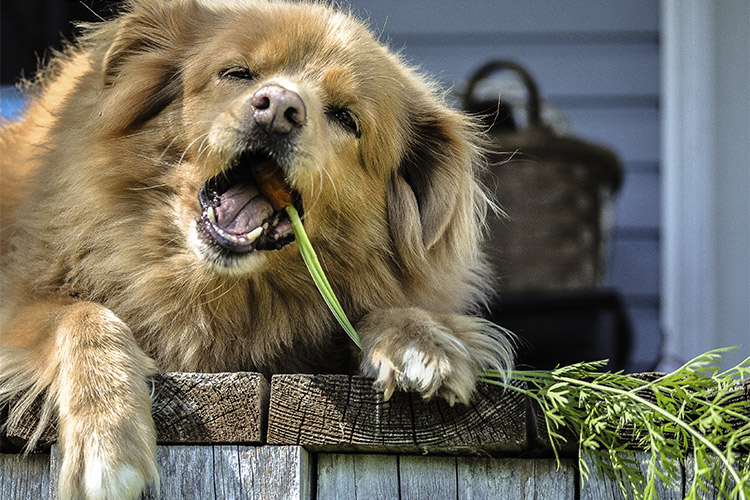Hey Ollie blog readers! We’re offering you an exclusive 60% OFF your starter box! Try now!
Fiber for dogs is an important component of a balanced diet. This nutrition buzzword is often touted as promoting good digestion in humans, and it does the exact same thing for your pup. Dietary fiber helps to promote regular bowel movements and maintain a healthy colon. Here’s what kind of fiber is best for your four-legged friend and how much roughage he really should eat.
What Do We Mean by Fiber for Dogs?
There are two types of fiber for dogs: soluble and insoluble. Soluble fiber absorbs water and ferments in the stomach, releasing gases as it travels through the colon. For dogs, soluble fiber increase stool bulk. It can be found in many human-friendly foods like fruits and vegetables. Insoluble fiber also absorbs water, but doesn’t ferment. For dogs, insoluble fibers helps food move through the intestinal tract. Insoluble fiber can be found in grains like whole-grain products, buckwheat, brown rice, and oat bran.
What Kind of Fiber is Best for Dogs?
Fiber comes in the form of carbohydrates, and both soluble and insoluble fiber are important in a dog’s diet. When it comes to fiber for dogs, the best question to ask is what kinds of sources it’s coming from.Mass market dry kibble often over-carbs our dogs with cheap fillers like corn. And even some “with fiber” labels on dog food are misleading, since the source of that fiber could literally be shredded paper. You won’t see this on the label, of course.t gets a fancier name on ingredient lists like “cellulose,” which is a broad term generally used to disguise subpar ingredients. The best kind of fiber for dogs is natural fiber of course. Avoid icky ingredients and feed your dog fiber from whole foods with human-grade Ollie dog food.
Benefits of a High Fiber Diet for Dogs
Technically speaking, fiber isn’t an essential nutrient for canines, but it is an important part of a dog’s diet.. “High-fiber” on dog food labeling often just means “food with fiber.” There’s no hard and fast rule for how much fiber your dog needs. Instead, watch for warning signs that your dog might not be getting enough fiber. Red flags include…
- Constipation and diarrhea: The remedy for both the runs or the plugs is fiber. If your dog suffers from one or both of these conditions, more fiber will keep the conveyor belt of digestion working at a more consistent pace.
- Obesity: Overweight dogs benefit from a fiber-rich diet because fiber offers a lot of bang for the buck when it comes to feeling full.
- Diabetes:Fiber can be useful in the regulation of blood glucose levels, helping dogs avoid dangerous spikes in blood sugar.
- Anal gland disease: Smaller dogs, in particular, can suffer from anal gland problems in which the glands become plugged and irritated. Fiber can help “bulk up” stools, applying pressure to the glands from the inside and allowing them to excrete naturally.
So the long and short of it is that fiber is helpful when it comes from a good source and is portioned appropriately as part of a balanced diet.
The Ollie blog is devoted to helping pet parents lead healthier lives with their pups. If you want to learn more about our fresh, human-grade food, check out MyOllie.com.
Tagged As:

The nutrition your dog needs,
the food they want.

Enjoying our articles? Subscribe our Newsletters and get new articles directly to your inbox
You might also like
26 August 2025
4 MINS READ
Is Fresh Dog Food Safe?
If you’re thinking about switching your dog to a fresh food diet, you might be asking yourself: “Is fresh dog food safe?” It’s a smart question—because feeding fresh means you’re worki…
by Ollie Pets
26 August 2025
4 MINS READ
How Do I Know How Much Fresh Dog Food To Feed?
If you’ve switched your pup to fresh food, you’re probably wondering: “How much fresh dog food should I feed?” It’s not as simple as scooping kibble from a bag—fresh food is more nutri…
by Ollie Pets
26 August 2025
4 MINS READ
Do I Need To Cook Fresh Dog Food?
If you’ve just started exploring fresh dog food, you might be wondering: “Do I need to cook it?” or “Is it raw or already cooked?” It’s a common question, especially with so many pet f…
by Ollie Pets







